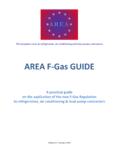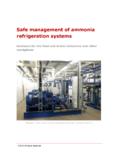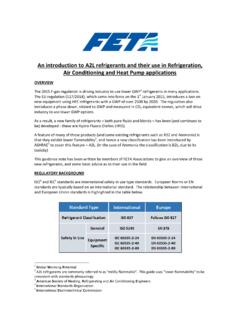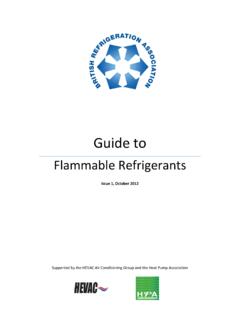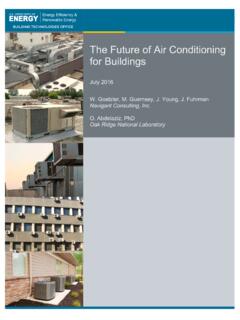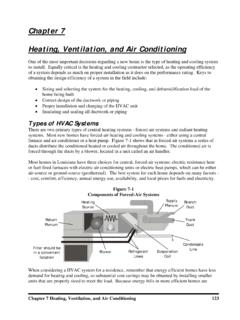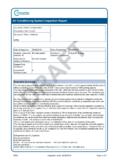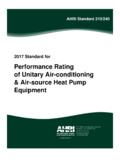Transcription of Safe management of ammonia refrigeration systems
1 2016 All Rights Reserved Safe management of ammonia refrigeration systems Guidance for the food and drinks industries and other workplaces Photograph: shows a modern ammonia refrigeration plant room - courtesy of Nestl UK. Safe management of ammonia refrigeration systems Page 2 of 49 January 2016 FOREWORD This guidance has been developed by industry, following the withdrawal of HSE's publication PM81, to give clear current cross-sector guidance on the safe management of ammonia refrigeration systems . This guidance may go further than the minimum needed to comply with the law. The guidance was written by the Food Storage and Distribution Federation s Technical and Safety Committee, British Engineering Services, Institute of refrigeration and other stakeholders, with support from the Health and Safety Executive. This guidance should be read in conjunction with: Safety of pressure systems , the Approved Code of Practice and guidance for the Pressure systems Regulations 2000 (PSSR) Dangerous substances and explosive atmospheres, the Approved Code of Practice and guidance for the Dangerous Substances and Explosive Atmospheres Regulations 2002 (DSEAR).
2 The HSE webpages on pressure systems , fire and explosion and DSEAR. The guidance is also supported by the air conditioning and refrigeration Industry Board (ACRIB) whose members are: Full Members Federation of Environmental Trade Associations. refrigeration , air conditioning and Heat Pump Group of Building & Engineering Services Association. Institute of refrigeration . Associate Members Associated air conditioning and refrigeration Contractors. British Frozen Food Federation. Cambridge refrigeration Technology. Chartered Institution of Building Services Engineers. Food Storage and Distribution Federation. Safe management of ammonia refrigeration systems Page 3 of 49 January 2016 CONTENTS FOREWORD 2 MAIN GUIDANCE INTRODUCTION 5 THE HAZARDS OF ammonia 5 THE RISKS FROM ammonia refrigeration systems 8 MANAGING THE RISKS 8 IDENTIFYING THE RISKS AND MEASURES NEEDED 9 SELECTION OF PLANT 11 INSTALLATION OF PLANT 12 MODIFICATION AND REPAIR 13 SAFE OPERATING LIMITS 13 MAINTENANCE 14 EXAMINATION 14 EMERGENCY ARRANGEMENTS 16 ENVIRONMENTAL PERMITTING REGULATIONS 2010 17 ORGANISATION OF THE MEASURES 17 APPOINTMENT OF COMPETENT ASSISTANCE 17 CO-ORDINATION 18 COMMUNICATION AND RECORDS 18 COMPETENCE 19 CONTROLLING THE MEASURES 20 MONITORING AND REVIEWING THE MEASURES 20 Safe management of ammonia refrigeration systems Page 4 of 49 January 2016 APPENDICES APPENDIX 1 SAFETY CRITICAL ASPECTS OF ammonia refrigeration systems 21 APPENDIX 2 PROTECTION OF ELECTRICAL AND MECHANICAL APPARATUS NEAR ammonia COMPRESSORS AND refrigeration PLANT 26 APPENDIX 3
3 RECOMMENDED SCHEDULE FOR INSPECTION AND MAINTENANCE OF refrigeration systems (BASED ON APPENDIX G OF THE INSTITUTE OF refrigeration SAFETY CODE FOR COMPRESSION refrigeration systems UTILIING ammonia ) 30 APPENDIX 4 STATEMENT FROM HSE CONCERNING THE INTERPRETATION OF THE TERM USER IN THE PRESSURE systems SAFETY REGULATIONS 2000 41 APPENDIX 5 EMERGENCY PROCEDURES AND TOXIC LEVELS OF CONCERN 43 APPENDIX 6 FURTHER GUIDANCE 47 Safe management of ammonia refrigeration systems Page 5 of 49 January 2016 INTRODUCTION has been used as a refrigerant in industrial applications for more than150 years. It continues to be the refrigerant of choice in many food processingand storage applications, and has seen increased use in building services andprocess applications. ammonia is an excellent natural refrigerant and offers anumber of significant environmental and operational benefits over its syntheticrivals. Environmentally it has zero ozone depleting potential (ODP) and zerodirect global warming potential (GWP).
4 Guidance has been prepared by the Food Storage and DistributionFederation s Technical and Safety Committee (TASC) and RSA EngineeringInspection and Consultancy Services together with the Institute of refrigeration inconsultation with HSE and other industry stakeholders. It applies to new andexisting installations (whether permanent or temporary) and indicates theprecautions a risk assessment would identify as reasonably practicable to achievecompliance with the detailed legal provisions. While the general approach willapply equally to existing and new installations, it may not always be reasonablypracticable to make changes to some engineering controls or modify the plant atsome existing systems . The risk assessment will identify this and the appropriaterisk management procedures to be applied in these circumstances. The controlswould be expected on new plant. This guidance applies to industrial andcommercial refrigeration plant in the food and drinks industry and is relevant forapplications in other workplaces, for example ice-rinks and the petro-chemicalindustry.
5 It does not cover domestic or transport HAZARDS OF ammonia is a gas with a distinctive pungent odour which can normally bedetected by smell at concentrations as low as 5 parts per million (ppm). Higherconcentrations are easily detected. It is colourless, lighter than air and acute toxicity of ammonia is a major consideration in the safe design andoperation of refrigeration systems . Although the odour of ammonia can bedetected by smell at concentrations above 5 to 10ppm people who are used to itcan work without discomfort in concentrations of approximately between approximately 150ppm and 200ppm will cause irritationof the mucous membranes and the eyes, but normally with no lastingconsequences. From approximately 500ppm to 700ppm, the eyes are affected1 Throughout this guidance ammonia means Anhydrous ammonia used as a refrigerant. Anhydrous ammonia has been assigned the unique Chemical Abstracts Service (CAS) registration number 7664-41-7.
6 It is also commonly referred to by its ASHRAE refrigerant classification, R717. ASHRAE - (Formerly the American Society of heating , Refrigerating and air conditioning Engineers), founded in 1894, is a building technology society with more than 50,000 members worldwide. Safe management of ammonia refrigeration systems Page 6 of 49 January 2016 more and more quickly, streaming with tears after 30 seconds or less, but the air is still breathable. approximately 1000ppm, breathing is intolerable and vision is impaired but notlost. Eye injuries constitute the most serious hazards at this concentration interms of possible permanent disability. Exposure to concentrations ofapproximately 1500ppm and above will damage or destroy tissue, and the instanthuman reaction, even for trained people, is to quickly evacuate the of approximately 2500ppm and above will rapidly increase the riskof should be noted that the effect of ammonia is a function of concentration leveland length of exposure time.
7 Higher concentrations can be tolerated for shortperiods but the effect of ammonia breathed into the lungs or in the eyes canpersist for long periods after the person affected has returned to an area wherethere is fresh air. All of the acute toxic effects of ammonia are due to the removalof water from affected tissue, which is why even small liquid splashes can causepermanent damage. There are no chronic toxicity effects of ammonia . The workplace exposure limits (WELs) have been set to protect workers from both long-term and short-term effects of exposure to ammonia . The 8-hour time weightedaverage (TWA) is 25ppm and the short-term limit measured over a 15 minutereference period is forms a flammable atmosphere at concentrations between 16 and 25%by volume in suppliers have a requirement to classify the product, provide hazardinformation (safety data sheets) and provide safe packaging in accordance withthe CLP Regulations2 (see for further information).
8 The intention of theCLP Regulation is very similar to the Chemicals (Hazard Information andPackaging for Supply) Regulations 2009 which they replace substances and2 The European Regulation (EC) No 1272/2008 on classification, labelling and packaging of substances and mixtures the CLP Regulation came into force in all EU member states, including the UK, on 20 January 2010. The CLP Regulation: Adopts in the EU the Globally Harmonised System (GHS) on the classification and labelling of chemicals; Was phased in through a transitional period which ran until 1 June 2015. The CLP Regulation applies to substances from 1 December 2010, and to mixtures (preparations) from 1 June 2015; Applies directly in all EU member states. This means that no national legislation is needed; Is overseen by the European Chemicals Agency (ECHA); Replaced the Chemicals (Hazard Information and Packaging for Supply) Regulations 2009 CHIP from 1 June 2015 The intention of the CLP Regulation is very similar to CHIP substances and mixtures that are placed on the market should be classified, labelled and packaged appropriately.
9 But because CLP adopts the GHS, in time, the same classifications and labelling will be used throughout the world. Safe management of ammonia refrigeration systems Page 7 of 49 January 2016 mixtures that are placed on the market should be classified, labelled and packaged appropriately. ammonia is classified under these Regulations as flammable and toxic, to be labelled with the following hazard statements and precautionary statements3 Hazard statement: H280 Contains gas under pressure; may explode if heated. H221 Flammable gas. H331 Toxic if inhaled. H314 Causes severe skin burns and eye damage. H400 Very toxic to aquatic life. EUH071 Corrosive to the respiratory tract. Precautionary Statement Prevention: P210 Keep away from heat/sparks/open flames/hot surfaces. - No smoking. P280 Wear protective gloves/protective clothing/eye protection/face protection. P260 Do not breathe gas, vapours P273 Avoid release to the environment. Precautionary Statement Response: P377 Leaking gas fire: Do not extinguish, unless leak can be stopped safely.
10 P381 Eliminate all ignition sources if safe to do so. P303 P361 P353 P315 IF ON SKIN (or hair): Remove / Take off immediately all contaminated clothes. Rinse skin with water/shower. Get immediate medical advice/attention. 3 Although the CLP hazard pictograms are very similar to the CHIP hazard symbols, they have a new shape, new design and a new colour. CLP hazard statements replace CHIP risk phrases and CLP precautionary statements replace CHIP safety phrases. Safe management of ammonia refrigeration systems Page 8 of 49 January 2016 P304 P340 P315 IF INHALED: Remove victim to fresh air and keep at rest in a position comfortable for breathing. Get immediate medical advice/attention. P305 P351 P338 P315 IF IN EYES: Rinse cautiously with water for several minutes. Remove contact lenses, if present and easy to do. Continue rinsing. Get immediate medical advice/attention. Precautionary Statement Storage: P403 Store in a well-ventilated place.
